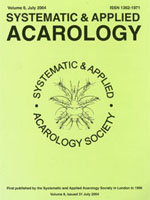Arrenurus truncatellus and A. castaneus have similar adult morphology and some consider them to be synonymous. Here, larval morphology was examined to determine if their separation is warranted. Larvae of the two species differ in the shape of the dorsal plate, CpI/CpII/CpIII ratios and pectination of C1, C2, C3, C4, IITi10 and IIITa13 setae. The most distinct morphological differences between larvae of A. truncatellus and A. castaneus are different locations of ITa13, IITi10 and IIITi10 setae. Therefore, the two species are considered separate. The description of the larval morphology of A. truncatellus is compared with that given by Stechmann (1977).
How to translate text using browser tools
1 June 2009
Larval morphology distinguishes Arrenurus truncatellus (O. F. Müller, 1776) and A. castaneus Neuman, 1880 (Acari: Parasitengona: Arrenuridae)
Andrzej Zawal
ACCESS THE FULL ARTICLE

Systematic and Applied Acarology
Vol. 14 • No. 1
June 2009
Vol. 14 • No. 1
June 2009
Hydrachnidia
larval morphology
Truncaturus
Water mites




